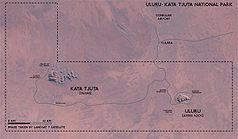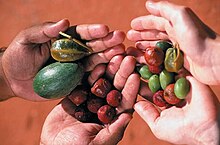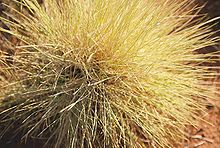Uluṟu Kata Tjuṯa National Park
| Uluṟu Kata Tjuṯa National Park | ||
|---|---|---|
| Uluṟu with Kata Tjuṯa in the background in the dawn | ||
|
|
||
| Location: | Northern Territory , Australia | |
| Specialty: | Uluṟu (Ayers Rock), Kata Tjuṯa (Mount Olga) | |
| Next city: | Yulara - Alice Springs | |
| Surface: | 1326 km² | |
| Founding: | 1987 | |
| Visitors: | 400,000 (2000) | |
| Map based on a Landsat 7 image | ||
| Uluṟu Kata Tjuṯa National Park | |
|---|---|
|
UNESCO world heritage |
|

|
|
| Uluṟu in the evening |
|
| National territory: |
|
| Type: | Culture, nature |
| Criteria : | v, vi, vii, viii |
| Reference No .: | 447 |
| UNESCO region : | Asia and Pacific |
| History of enrollment | |
| Enrollment: | 1987 (session 11) |
| Extension: | 1994 |
The Uluṟu-Kata-Tjuṯa National Park (English: Uluṟu-Kata Tjuṯa National Park , formerly Ayers Rock National Park ) is a national park in the Northern Territory , which is listed by UNESCO as a World Heritage Site and World Heritage Site . It is located 1,431 km south of Darwin and 440 km southwest of Alice Springs along the Stuart and Lasseter Highways . The park covers 1326 square kilometers. Parts of the park are the famous Uluṟu (Ayers Rock) and 40 km west of Kata Tjuṯa (Mount Olga). The main tourist settlement is Yulara .
introduction
Uluṟu is Australia's most famous natural landmark. This Inselberg rises 348 m above the landscape. The word Kata Tjuṯa means “many heads” and describes a group of 36 rocks, the material of which is more than 500 million years old and was exposed by the erosion about 300 million years ago. Uluru Kata Tjuta and are of the territory, which for the original inhabitants Anangu - Aboriginal , culturally significant and special taboo subject. Today they also organize guided hiking tours, on which you can learn more about the flora, fauna and traditional bush food of the area as well as about the stories of the dream time .
The Anangu Aborigines are the owners of the Uluṟu-Kata-Tjuṯa National Park. They believe that their culture has always existed in Central Australia and was created by their ancestors in the beginning of time.
In 1976, the Aboriginal Land Rights (Northern Territory) Act recognized the rights of the Aborigines; 9 years later, in 1985, they received the freehold title for the area of the park. They leased the land back to the Australian government for 99 years. Since then, Anangu and Parks Australia have been working together as part of “joint management”. Its aim is to preserve the Anangu culture, to maintain an ecological balance and to give visitors an insight into the culture and history of the park.
Establishment
In 1987 the Uluṟu National Park was listed as a UNESCO World Heritage Site . In 1993 the name was officially changed to Uluṟu-Kata Tjuṯa National Park and the following year it was also listed as a World Heritage Site. This internationally recognized listing was a significant victory for the Anangu. In 1995 the Uluṟu Kata Tjuṯa National Park won the Picasso Gold Medal, the highest UNESCO award, for the preservation of nature and the preservation of the Anangu culture. The National Parks and Wildlife Conservation Act of 1975 was superseded by the Environment Protection and Biodiversity Conservation Act of 1999 in July 2000 . The park area originally comprised an area of 132,550 hectares and also includes a depth of 1000 meters. Another 16 hectares were added on October 21, 1985.
history
Europeans first traveled to the western desert regions of Australia around 1870. Uluṟu and Kata Tjuṯa were mapped by the Europeans during the construction of the Overland Telegraph Line in 1872. William Ernest Powell Giles and William Christie Gosse were the first Europeans in the area. During an expedition in 1872, Ernest Giles saw Kata Tjuṯa from Kings Canyon and named it Mount Olga , while Gosse discovered Uluṟu and named it Ayers Rock after Sir Henry Ayers, the then Prime Minister of South Australia. Further expeditions with the aim of colonizing the area followed. Between 1918 and 1921, large parts of South Australia , Western Australia and the Northern Territory were recognized as Aboriginal Reserves, as a refuge for the indigenous people of Australia. In 1920 part of today's Uluṟu-Kata-Tjuṯa National Park was declared an Aboriginal reserve by the Australian government under the well-known name of South-Western or Petermann Reservation.
In the late years of the 19th century, some settlers tried to settle in the areas of the Petermann reservation, and there were sometimes violent clashes with the Anangu .
Especially in times of drought, the lack of food led to clashes between Aborigines and farmers; Police forces were used to protect the farmers.
The first tourists visited the Uluṟu area around 1936. From 1940 onwards, the main reasons for Europeans to settle in the area were Aboriginal welfare and the development of tourism for Uluṟu.
In 1948, the first paved road to Uluṟu was built to promote tourism in the area. The first companies with bus tours established themselves as early as the early 1960s. To further promote this tourism, the Northern Territory Reserves Board took over the management of the park, which was then called Ayers Rock - Mt Olga National Park . The first ranger was Bill Harney, well known in Australia. In 1959 Eddie Connellan received permission to open a motel and operate an airstrip north of Uluṟu.
Climate & Seasons
The average precipitation in the park is 307.7 millimeters per year. The temperature is up to 45 ° C (113 ° F ) in summer and around -5 ° C (23 ° F) in winter time.
The UV radiation can be between 11 and 15 on hot summer days.
At first glance, the landscape of Central Australia may look deserted, but upon closer inspection, one can discover life in the desert. Animals and plants have adapted to the extreme climate and form a unique biotope. Many of these animal and plant species were used by the traditional owners, the Aborigines, as medicine or as a source of food.
The Aborigines distinguish six seasons in Central Australia :
- Piryakatu (August / September) - animals reproduce, flowers bloom
- Wiyaringkupai (October / November) - Hot time, food is scarce
- Itanju- (January / February) Isolated sudden storms
- Wanitjunkupai (March) - Colder weather
- Tjuntalpa (April / May) - clouds come from the south
- Wari (June / July) - Cold time, morning brings frost
geology
The history of the formation of the formations in Uluṟu-Kata-Tjuṯa and Watarrka National Park is very complicated and not yet fully understood. The two areas are located in the Amadeus Basin , the very old sedimentary basin of a former inland sea. The deposits solidified into sandstones and conglomerates from the long period of the Proterozoic reached a thickness of up to 14 km in many layers and were unfolded towards the end of the Proterozoic, 700-600 million years ago, in the course of the Petermann orogeny . The erosion of these mountain ranges led to the formation of alluvial fans that reached sediment thicknesses of at least 2500 m. The rocks that make up both Uluṟu and Kata Tjuṯa date back to this alluvial fan sedimentation at the turn of the Neoproterozoic to the Cambrian , about 550 million years ago. In a new inland sea phase, these alluvial fans were consolidated. 400 to 300 million years ago, in the Devonian , the sea retreated again, the earth's crust in the region was folded and lifted once more. This event is called Alice Springs orogenesis . It also affected the strata to which Uluṟu and Kata Tjuṯa belong.
Uluṟu and Kata Tjuṯa are protruding layer heads of two completely different sediment compartments, exposed by erosion , which are particularly hard compared to the other layers of the Amadeus sedimentation, which have fallen victim to erosion since the Mesozoic Era and are buried under sand. The Uluṟu consists of arkose , a fine-grained sandstone (grain size Ø ≤ 2 mm) with feldspar proportions ( "Mutitjulu-arkose"). Kata Tjuṯa made of coarse-grained conglomerate, cemented rubble the size of a fist and larger ("Mount Currie conglomerates"). The red to rust-brown color of these rocks is caused by hematite , an iron oxide.
flora
The flora of the Uluṟu-Kata-Tjuṯa National Park represents a large number of all species found in Central Australia. Some of these species are rare and can only be found in the area of the park and are therefore endemic to the Uluṟu-Kata-Tjuṯa region. Other species that can be found in other areas of Central Australia, however, are rare in the park and are considered threatened.
Overall, the flora is well adapted to the extreme climate. The reproduction of the plants is directly related to the rare rainfall. Some plant species survive bush fires and need these fires to reproduce. The flora is an important part of the dreamtime culture , called Tjukurpa, and there are different ceremonies for the main food plants. In addition, they are associated with ancestors. The gathering of edible plants is of cultural importance and can be seen as a traditional link between the country and the Tjukurpa.
The flora of the park can be divided into the following subgroups:
- Punu - trees
- Puti - shrubs
- Tjulpun-tjulpunpa-flowers
- Ukiri - grasses
Trees like the Mulgabusch and Bloodwood, a eucalyptus genus were used to spear heads, boomerangs manufacture and vessels. The red sap of the Bloodwood tree was used as a disinfectant and as an inhalant for colds.
Other trees such as the River Red Gum, also a eucalyptus and Duboisia species such as the silver oaks and Hakeas are in themselves a source of food. The white crust of the leaves of the River Red Gum tree can be rolled into balls and eaten like a lollipop. The nectar of the silver areas can be converted into a sweet juice. The witchetty bush looks similar to the mulga bush and parts of the roots are edible.
Daisies and other near-earth flowers bloom after the rain and in winter. Other types of flowers and some types of acacia bloom in spring. The Anangu collect the acacia seeds, grind them and mix them with water. This creates an edible porridge that can be eaten raw. To make damper, an Australian dough dish, the seeds are placed in the hot sand so that the shell of the seeds comes off.
Spinifex , a genus of prickly sweet grasses , have a pronounced root system that prevents the desert sand from blowing away. The Anangu use a type of spinifex to make rubber. The bush is beaten on the ground until it dissolves into small pieces, which are then heated and form a tar-like liquid. This rubber is used for hunting and tools. Another important source of food is a native variety of millet . It is used to make flour for damper.
There are some rare and endangered plant species in the park, such as a species of snake tongue family . These are limited to the slightly more humid area on the edge of the Uluṟus.
Some plant species such as buffalo grass were first introduced by the Europeans to prevent erosion. Today it is a weed that has mainly spread near water holes and hinders the spread of other grasses. Other plant species were brought in by cars.
Rules in the park
The rules in the park are very restrictive and exceeding them will result in heavy fines. The amount of the fines is taken from the catalog of the national park administration (status 2004). The selection for bans listed here corresponds to what is rather unusual by European standards (prices in Australian dollars):
| description | Fine in Au dollars |
|---|---|
| Conduct scientific research | 2,200 |
| Bringing ground material | 5,500 |
| Attend or hold meetings of more than 15 people | 1,100 |
| Use films, pictures, drawings or sound recordings for commercial purposes | 3,300 |
| General commercial activity | 3,300 |
| Drive or walk outside of the marked paths | 550 |
| Disregard of safety instructions | 3,300 |
| Entering a forbidden or restricted area | 5,500 |
| Setting up posters, flags, signs | 500 |
| Unauthorized parking or stopping, disruption of other traffic | 330 |
Other prohibited activities include a. entering and taking photos of the holy places of the Anangu or visiting the Mutitjulu community (living area of the Anangu). This reduces the tourist radius to the area of a path around the Uluṟu, some selected caves and the ascent of the summit. A large part of the street on the sunset side belongs to the no-parking zones, so that closer observation is only possible from the marked parking lot.
The usual prohibitions on the protection of the flora and fauna, environmental pollution, fire, wild camping or hunting also apply.
Visitor numbers
The park administration's records are apparently incomplete, the following data was taken from a diagram:
| year | number of visitors |
|---|---|
| 1962-65 | ~ 10,000 |
| 1968-69 | ~ 25,000 |
| 1984-85 | ~ 100,000 |
| 1990 | 250,000 |
| 1995 | 300,000 |
| 2000 | 400,000 |
swell
- ↑ http://www.unesco.de/welterbeliste.html World Heritage List (as of August 2010)
- ↑ Welcome to Aboriginal land: Uluru-Kata Tjuta National Park; visitor guide and maps, Colemans Printing, Darwin, January 2006.
- ↑ Website of the Australian government ( Memento of July 2, 2015 in the Internet Archive )
- ↑ It should be noted that the representation given in the English Wikipedia Uluṟu-Kata Tjuṯa National Park (accessed on May 15, 2015) does not apply (File: Schema Kata Tjuta Uluru.png), see website of the Australian government ( Memento from 2. July 2015 in the Internet Archive )
Web links
- Geology of Uluru-Kata Tjuta National Park, website of the Australian government ( memento of July 2, 2015 in the Internet Archive )
- Official website of the Uluṟu Kata Tjuṯa National Park
- Official tourist information site
- AUSTRALIEN-INFO.DE: Description of the park and its sights
- Entry on the UNESCO World Heritage Center website ( English and French ).











